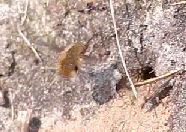
Hovering is the ability exhibited by some winged animals to remain relatively stationary in midair. Usually this involves rapid downward thrusts of the wings to generate upward lift. Sometimes hovering is maintained by flapping or soaring into a headwind; this form of hovering is called "wind hovering", "windhovering", or "kiting". [1] [2]















































